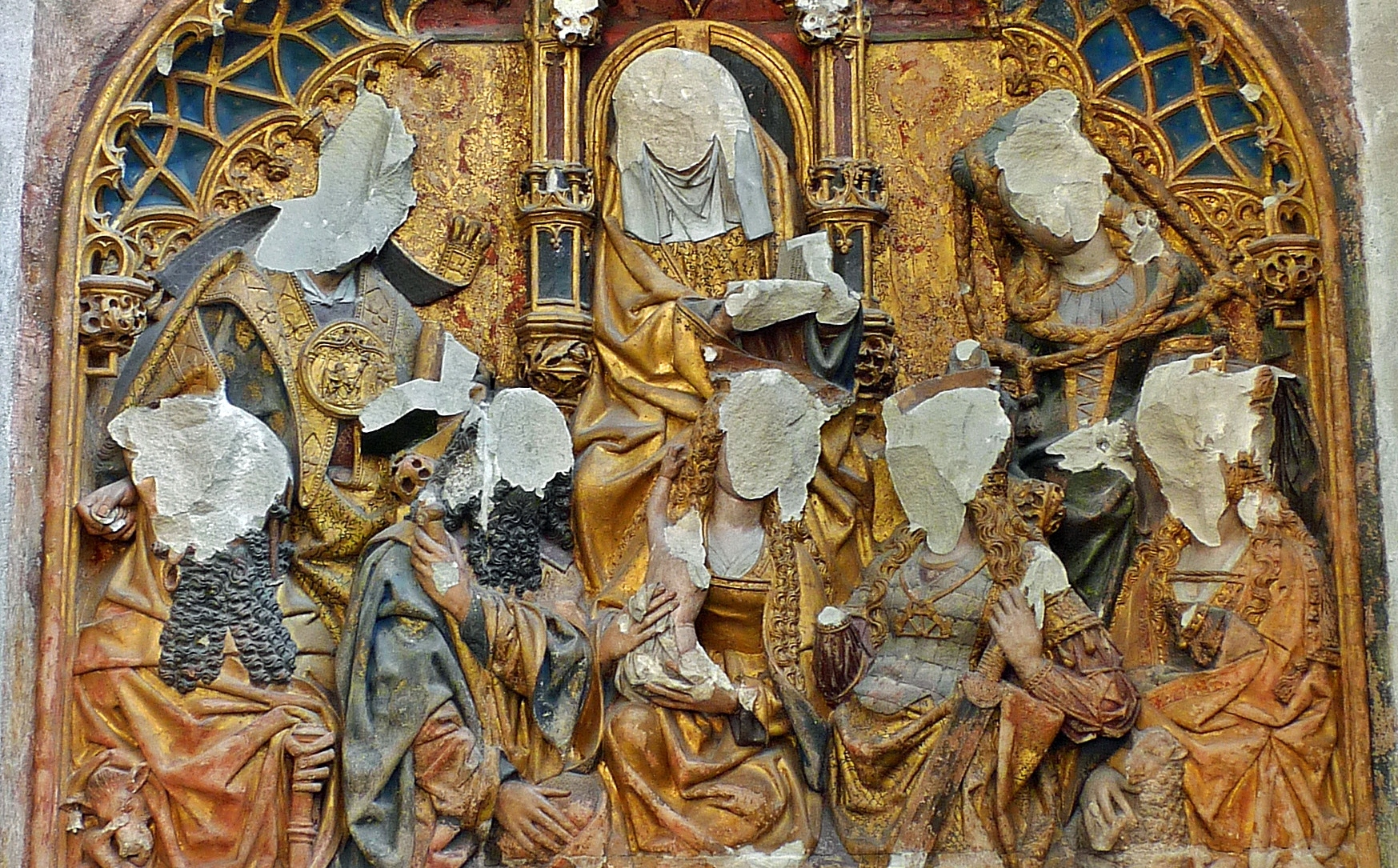Part 4- Protestants Gone Wild
Above: The Garden of Earthly Delights, detail – right panel (1515) by Hieronymus Bosch
Paranoia Will Destroy Ya
Dear Dad,
Sorry we burned your KISS album in 1989. We were persuaded to believe the devil lived in that music. I, Michelle, as restitution would be willing to give you my Michael Jackson Thriller album which I still have (does have a small scratch on it from jumping on the bed with our record player). The Man of God who told us how Satan fills rock music with evil subliminal messages didn’t say anything about the King of Pop, so that music must be safe.
Regrettably,
Your Daughters
Luther vs. Pandemonium
Maybe if Martin Luther had not been hidden away in Wartburg Castle, certain radical and violent purgings of suspected evils would not have reared their ugly heads. Then again, Luther may not have been able to stop where other Reformers deemed it necessary to venture. (In a later blog post, I will explore the Reformation’s iconoclastic second wave which came after Luther’s death.) It seems that every age (even my own teenhood) has it’s panic attack and subsequent reactive frenzy to destroy the devil where he is said to reside. Luther’s colleague back in Wittenberg, Andreas Karlstadt, opened the doors to mass destruction of sacred art while Luther toiled away on his New Testament translation in his secret mountain-side chamber. Though Luther’s sword of free-thinking had effectively wounded the dragon, AKA the Church, he would not be able to conquer the monster released by Karlstadt and other Reformers against religious art…a new (but old) creature known as FEAR:
“Why have we had images painted with satin and damask…and adorned them with gold crowns?…Statues are hideous, and it follows that we become hideous if we love them. They strangle their worshipers,…so that our [churches] can be called murderers’ graves, for our spirit is killed in them.” – Andreas Karlstadt, 1522*
With words like strangle, murder and kill, you can just feel the anxiety level in everyone increase. Adding injury to insult (Boy, am I glad this guy isn’t on social media):
“Artists, as the perpetrators of the images, are good for nothing and understand nothing…Who then can say that their images are useful?…They have forgotten that the images’ eyes do not see, nor do their hearts understand.” – Andreas Karlstadt, 1522*
Wow, thanks dude. <eyeroll>
In the spring of 1522, Luther came out of his hiding and went straight to work refuting the words and actions of Karlstadt. Luther traveled the area preaching a series of eight sermons to convince the people against the ensuing iconoclastic-craze:
“As for images, the situation is that they are unnecessary but free. We may want to have them or not to have them. The worshiping is forbidden, not the making. For in my opinion there is no person who would not have sufficient understand it to be able to say: The crucifix standing there is not my God, for my God is in heaven. It is only a sign. Therefore I must admit: images are neither one thing nor another, neither good nor wicked. One may have them or not…It is possible that there may be people who can make good use of images.”* (emphasis mine)
Along with his artist-friend, Lucas Cranach the Elder, Luther convinced the Wittenberg City Council to depose Karlstadt. Karlstadt went to Zurich, Switzerland. Here he found an ally with fellow iconoclast thinker, Ulrich Zwingli, who had already stripped the Zurich cathedral and white-washed its walls to now display only the portraits of important pastors.
*featured quotes from Likeness and Presence: A History of the Image Before the Era of Art (1994) by Hans Belting
The Fear Factor

Relief in Utrecht Cathedral, desecrated in 1566 during the iconoclasm in the Netherlands (a headless baby Jesus held by His now headless mother at center).
What chiseled the faces of saints from the walls and exterior church facades? Fear. What tore down altar pieces, smashed crosses and stained glass? Fear. What destroyed countless pieces of sacred art across Europe and an estimated whopping 90% of Britain’s sacred art (according to the Tate, the home of Britain’s national art collection)? Raging Protestant fear.
“The fear that lay behind much Reformation activity was fear of one of the primal powers of art: the ability of the image to seem as real as a person, to come to life, and not only become an object of worship in its own right, but perhaps do evil to those who oppose it. This fear of the dangerous, potentially animate qualities of art may be detected in the methods of the destroyers. Defaced images often had their eyes scratched away, as though, by breaking visual contact between image and viewer, the suspect power of the image might be defused. The potent realism and the beguiling presence of the most affecting art of the pre-Reformation period may partly explain the violence of the reaction against it. Destruction can be seen as a kind of back-handed compliment. To deface or smash an image is to acknowledge its power.
The idealistic Protestants saw their destruction as a means of disproving the power of images and loosening the chains of superstitious belief which they felt had tightened around the minds of the laity.” – Andrew Graham-Dixon, British art historian*
*A History of British Art, p. 37 (1999) by Andrew Graham-Dixon
Super Sizing Jesus
About ten years ago there was a film that shook the nutritional foundations of our culture: “Super Size Me” by Morgan Spurlock. While the film aimed to call into question our fast-food habits, the more disturbing fact for me was his interviews with children. Spurlock showed images of people to the children and ask for them to identify who they were looking at. They all knew emphatically who Ronald McDonald was. The one image that the children interviewed could NOT identify was a representation of Jesus. That says something to me – we’re still dealing with the fallout of Protestant iconoclasm. watch clip>
From the top of the Internet to the bottom you will find that in today’s modern Western culture when it comes to selling or saying anything – all branding, marketing and advertising strategies are about the visual. You’ve got to have a compelling visual. There are articles and charts galore on color theory, white space, eye movement, attention-spans and layout strategies all geared toward accessing the visual learner in all of us. (It’s now scientific fact that ALL people learn with the aid of visuals. read more>)
I’m not saying that we should get Jesus’ face out there on billboards and commercials and mugs and T-shirts (although that could arguably be a modern strategy…I have seen a few attempts at it). No, I’m just advocating a little more presence in our own homes and our worship spaces. Unlike those Protestants who saw the empty, pristine-white chapel as the triumph over idolatry, I see it as a huge loss both to the teaching of the faith and the practice of prayer and devotion. Early Christian art was meant to instruct and interpret certain Biblical and theological truths. It was also a means of sharing a message, of presenting this new-found way of life and peace with the world. It never was just about illustration. It went deeper than that and always has.
Taking Action For Faith’s Sake
Ironically, the iconoclasm of the Protestant Reformation cannot be explained as only fear-crazed chaos. To be human is to be visual, but also visionary. When Martin Luther exclaimed that “Faith may, will and must have it’s images!” that statement rang true for artist and iconoclast alike. Nothing visually communicated the Protestant convictions of reading and thinking for oneself and taking a stand against the top-down, heavy-handed faith of the past like a clean, bright and airy worship space. The Protestant Reformation was about empowering the individual to be reflective and introspective. The tearing down of images was representative of a clean start and a new commitment to God. I get that!
If you have explored my website at all you may have seen some meditations that are featured under the GARDEN tab>. The meditation “Finding Healing in Action” is about how we can move forward in our faith and lives through simple physical actions, like throwing a stone into a body of water to symbolize the release of a hurt. I’m convinced that there is something to engaging our bodies when we need to “turn over a new leaf” or “let go.” Sure, we can do either of those in a purely mental capacity, but actually picking up the leaf and turning it over, using our muscles and body to help our minds store the new commitment is powerful. I encourage you to give this a try.
While fear may have been a driving force in stripping art from the chapels and cathedrals across Europe, underneath that fear was a basic need to put faith into action. I’m certain of this. When my sister and I burned my dad’s rock album we were putting our faith and commitment to Christ into action. It was a bit daring and exciting as life in Christ should be. In reflecting on that experience, I see now that its effects went deeper than positive feelings of having rid the world of some devil infused object. At the same time, I regret the action. While my sister and I might have thought we were removing a temptation to ourselves to listen to demonic music, the album was Dad’s. It’s always a bit dangerous to gallop ahead of others and dictate to them what is good or bad (except in the case of direct Scriptural instruction or parenting. Parents, please gallop ahead!).
Hey Dad, we were wondering…did you even like Kiss all that much?
Final thoughts
If we are to make progress in restoring the art and faith connection in the Protestant realm, it’s up to us to face that one dragon Luther could not slay (though he tried mightily). The same fear of idolatry that birthed the iconoclastic actions of the first Protestants echos deep into Protestantism today. In my own life, I had to face that fear head on – it didn’t disappear overnight and involved some serious struggles. I find I run into the same fear every time I travel somewhere new to talk about my work. It never fails that when I am finished speaking someone will tell me how they’ve always thought this stuff was idolatry. One woman professed to stuffing icons she found in her grown son’s home into drawers to hide them.
If you find it’s time to face the dragon, let me remind you first what God commands us humans throughout Scripture, “Fear not!” Secondly, here would be some great questions for you to ponder and discuss with each other:
- Do you remember hearing your parents, grandparents, pastors, or Sunday school teachers talk about images and idols? What did they have to say?
- Are you at all afraid of certain or specific works of Christian art?
- Is Christian art OK for the fellowship hall, Sunday school room or curriculum but not the sanctuary? Why or why not?
- What does an idol look like? Is it necessarily an image or statue?
If you feel like sharing your answer(s) with me, pop over to my contact page and send them to me along with any other questions or comments you may have. I thank you kindly for sharing this journey with me.
Additional Source: The Serpent and the Lamb: Cranach, Luther and the Making of the Reformation (2011) by Steven Ozment
Down an Ancient Path
The BIRCH TREE STUDIO BLOG
